Pine nuts are known not only in Siberia and the Far East, but also far beyond them. However, the main place of harvesting nuts occurs in the Siberian taiga.
Most of the cedar massifs grows on the rocky placers of Eastern Siberia, in the west, as well as in the mountainous regions of southern Siberia. In these regions, the collection of cedar nut is an important fishery for the population. After all, the seeds of Siberian pine represent a valuable food product.
Table of contents
When do pine nuts ripen in Siberia?
Siberian cedar is a wind-pollinated plant that has male and female inflorescences on the same tree. Brightly crimson shoots of male cones, located at the base of growth in the middle part of the tree. Female cones with shoots are in the upper part of the crown. The flowering period takes place in late May - early June. Since the formation of buds at the top of the shoot until the seeds mature, it takes 18 months. Ripe nuts begin at different times. The ripening time of pine nuts can be divided into several periods:
- In the embryonic spring-summer period, ovules form, bloom and pollinate. With the onset of a warm summer, cross-pollination and the formation of seeds occur.
- After pollination, the ovules become tarry and keep the pollen in themselves for 11-12 months. Reaching the size of 1.5 - 2 cm in length, ovules take the form of a cedar cone. Overwintered cones are called ozimyu.
- Winter cones grow intensively and by July reach 5-7 cm. The cover turns into a shell. A bulge appears. Yellow color is replaced by a reddish-brown. The shape, color and size may vary depending on the age of the tree and weather conditions.
- In September, the nut is ripening. Dark brown bumps with an oily core (up to 79.5% of the oil) become dry, not resinous and light. Seeds are separated from the scales of cones. Mature cones when gusts of wind or blow to the trunk easily break from the trees.
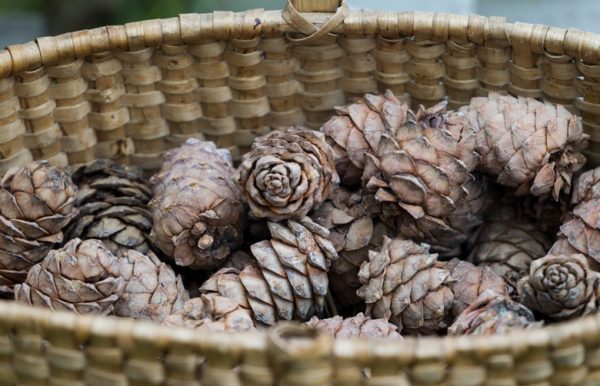
The period of maturity begins in mid-August - early September. In mountainous areas, maturation occurs later. The ripening period can be shifted by 1-2 weeks in one direction or another. The maturity of nuts in different areas, the quantity and quality of future harvests are due to the following factors:
- geographical location;
- terrain features — lowlands, plains, slopes, mountain elevations;
- growing conditions, the origin of the stand, the qualitative composition of forests;
- soil composition of land;
- age of trees;
- weather conditions.
It is the latter factor that largely determines the time of ripening nuts, and also affects the yield. With the onset of early spring, cedar blooms in early - mid-June. With the arrival of late spring - flowering occurs at the end of the month.
With favorable warm and relatively dry weather, pollination begins after a few days. In case of bad weather, it is delayed for 2 weeks. At this time, the formation of the crop. With a rainy cold summer, the growth of cones of the current year slows down, they become resinous, one-sided. The cold start of summer has a negative impact on the yield of the next two years.
Due to incomplete pollination, the number of empty seeds increases, having a negative effect on the development of buds. Too hot summer promotes smolii, negatively affecting winter.
Cedar trees do not have consistent seed yield. The yields of cedar trees may vary significantly in different areas, and within the same plantation. Cedar pine fruits every two years. Average and high yields occur in 4-8 years. That the tree was breaking from fruits, it happens extremely rarely - 1 time in 10-15 years.
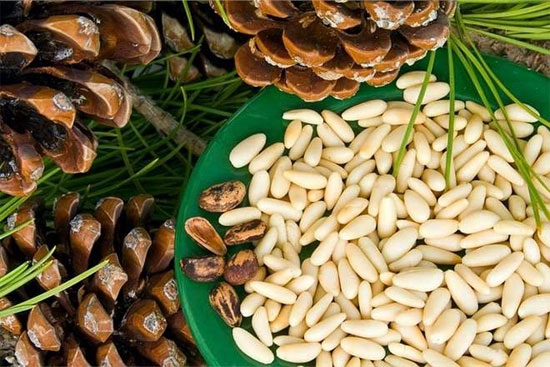
When are pine nuts harvested?
Traditionally, the season of picking pine nuts begins in early September, and in mountainous areas in the middle of the month. However, most often, walnut is harvested in Siberia.With a strong wind, mature buds on treetops are easily separated and fall. Swept along the slopes, they usually roll into heaps. Fallen cones are called padans.
Collect cones also begin when the fruits fall off when struck with a prick or shaking branches. Unscrupulous collectors begin to churn cones before they fully mature, thereby harming the food supply of forest animals and birds. Therefore, the local authorities officially set the dates for picking pine nuts.
Violation of the rules is punishable by a fine.
For the local population, the dates for picking cedar fruits are limited, since the hunting season begins next. Harvest season ends after the first snow. But, it can also be carried out in case of snowfall, depending on the weather conditions and the thickness of the snow cover. Autumn season ends in late September - early October. Finishing to knock down and collect the cones, proceed to their processing.
In addition to the autumn collection, there is also spring. Depending on the weather from April to May, there is a collection of cones.
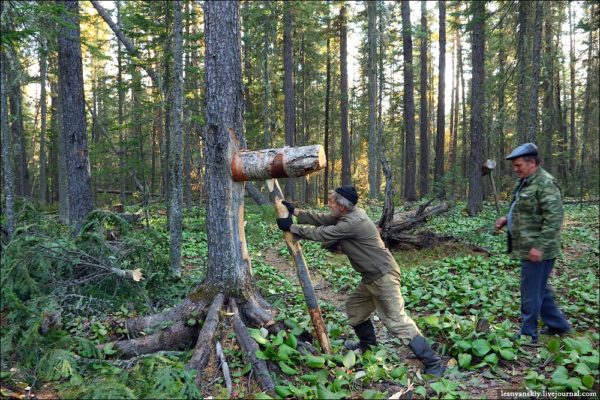
How to collect pine cones?
Harvesting nuts is a laborious and multi-step process. Therefore, several people are involved in the fishery. Getting off at the artels, they go into the taiga for weeks. In the forest camp and build temporary housing. Arrange storage space, peeling and sifting cones.
In search of fertile trees, sometimes you have to walk the distance, follow the trails of wild animals. After all, they feel better where the high-yielding cedar forests are located.
Cedar fruits are harvested in several ways:
- Pick up the fallen at the wind gusts of padanka. In this way do not harm nature. However, most cones are taken away by wild animals, and the cones are not evenly declining.
- Climbing trees. The collector climbs the trunk of a tree and with the help of a long pointed rod with a hook, hits the branches, knocking down cedar cones. Also knock the bumps off the branches with the help of long-flexible poles. This collection method is dangerous and less effective. Fallen bumps pick up and put in a bucket.
- Way lasagna with claws. Claws - special shoes with sharp iron spikes, with which it is easier to climb a tree. An additional insurance is a rope covering a tree trunk. Holding both ends of the rope, the person is in the same plane with the trunk, ensuring fast climbing and safety.
- A well-known method is to knock down cones with a log hammer - a hammer. Observing certain rules, a worker beats a giant hammer on a tree trunk. From a few strokes, the trunk and branches begin to fluctuate. With the characteristic noise of the gathering of cones. If the bumps are weak, they tie ropes or reins to the stab, one on each side. Two people, at the moment of impact, they pull down. After such a reception mature cones fall hail. At this point, the main thing is to dodge. For a person, this method is safe and beneficial in the ratio of time spent and the yield obtained.On the other hand, knocking the cones with a choke damages the trunk and bark of the tree, thereby causing damage. Experienced craftsmen hammering down a tree trunk with only one side, so that by the next harvest the wounds can be baked with resin. After churning, collect fallen cones in special gloves (tops) and put in bags.
In the camp, the harvested crop is passed through a drum or a special grater consisting of rollers and teeth. Cones are crushed and shelled. After sifting through a sieve and sweep. Dried crops in the camp. The dryer is made of wooden log. From above fastens an iron cloth with small openings. Peeled nuts are poured on a sheet. A weak fire is maintained in the inside of the log house. Dried nuts, stirring constantly. Overheated nuts lose useful properties, so it is best to dry the crop in the sun.
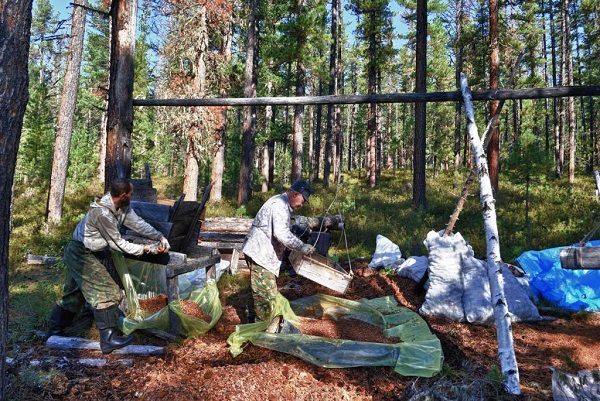
How to make a split for the extraction of pine nuts and how much does it weigh?
In the cedar fishery it is difficult to do without the chipping. Having not a complicated structure, you can do it yourself.The tool consists of a striker (chock) 65–80 cm long, 25–35 cm in diameter, and a leg (cutting) 2–2.5 m long. The chock is made from the butt of young birch or larch. In the lower part of the trunk do gash "dovetail". It is important that the handle passed through the center of the striker.
Washed down should be made at an angle so that the handle with the head could be held without the use of nails. The ditch should be perpendicular to the base of the chuck. This contributes to the strikes, after they pass the equilibrium point. The weight and length of a stake is largely dependent on the physical training of the worker and the qualitative characteristics of the trees. The harder the prick, the better the effect of knocking the cones. How much does he weigh? Weight ranges from 20 to 70 kg.
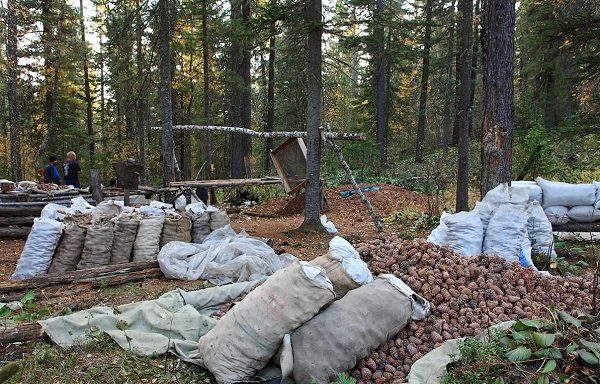
The following tips will help you to do it yourself:
- In cedar forests with massive trees, a heavier stockpile is used. For tall cedars, the stalk is lengthened.
- Many prefer to make a larch bead. It is durable and does not rot. From it you can use the hammer for 2-3 years, changing only the handle.
- The base is made of dry cedar, as it is softer to the touch and is more convenient to keep when hitting.
- Usually, the base of the stab is attached to the striker at a right angle. Having made a slope of 10-15 degrees from a right angle, the blow will be stronger. By placing the stab away from the barrel, when struck at the striker, a larger sweep is formed, and the slope contributes to an increase in the impact force.
When making a hammer, trappers try to take into account many features in the creation of the tool, as well as to improve the technique of impact. After all, it depends on this efficiency of harvesting. Cedar harvest - an important craft for the peoples of Siberia. Every year, in September, the season of gathering of cedar fruits opens. The collection involved the whole families. After all, pine nuts are extremely rich in oil, vitamins and proteins. Unpeeled nuts can be stored for a long time, but those that have been husked quickly deteriorate and rot. Therefore, it is important to start fishing at the right time, following all the rules for collecting nuts.
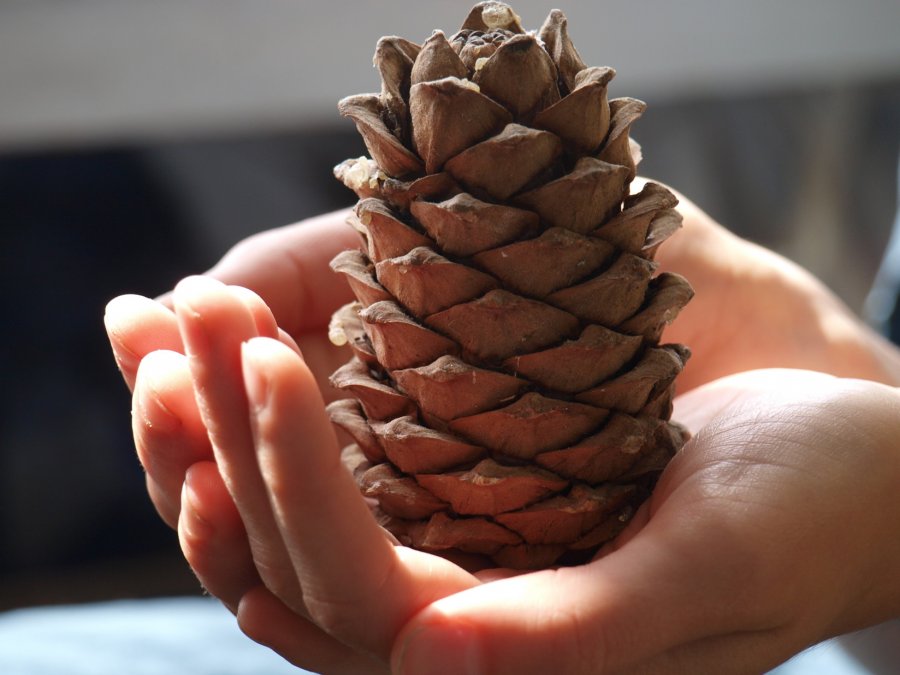
Barbarians! What wounds on the tree are left. Then they would heal the damage to the bark or tie a tree with a rag, and then they would pound it. And they say that everything is ours! His so do not spoil! Profit, and there, though the grass does not grow! Poor trees! This is the real destruction of the forest!
I wish the author of the article to old age to be the same as those damaged cedar trunks that beat the hunters who have read similar articles. Going into the cedar taiga sometimes a tear dims from the type of wounds that such clever men inflict. It is necessary to protect nature, and not to destroy it, thinking only about a profit.